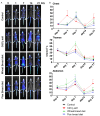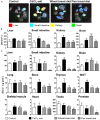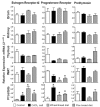Sexually immature male ERE-Luc reporter mice to assess low dose estrogen-like effects of CdCl2 versus dietary Cd
- PMID: 24795841
- PMCID: PMC3999407
Sexually immature male ERE-Luc reporter mice to assess low dose estrogen-like effects of CdCl2 versus dietary Cd
Abstract
CdCl2 salt is widely used in exposure oriented studies, while the biological exposure of Cadmium (Cd) occurs mostly through diet. Hence, we designed a in vivo imaging methodology with sexually immature male ERE-Luc reporter mice to test the estrogen-like (EL) effects of Cd as a natural component in wheat and flax bread based diets (containing 17.57 and 49.22 ug/kg Cd concentrations respectively) and CdCl2 per-oral dose of 1 ug/kg/bw/day. Total exposure of ingested and % bioaccumulation of Cd in selected organs were estimated as 547 ng (4.4%), 776 ng (0.3%) and 2131.8 ng (0.1%) corresponding to CdCl2, wheat and flax bread based diet treatments respectively. Cd from CdCl2 bioaccumulated more readily, despite the exposure of Cd is higher with bread based diets. Longitudinal in vivo imaging did not reveal significant changes in luciferase activity. White adipose tissue (WAT) and prostate were identified as novel target organs of Cd. Indeed, the rest of the observed EL effects, endogenous target gene expression and necropsy findings are not consistent to any particular organ or treatment. This implies that, the observed EL effects due to low doses of Cd (either from CdCl2 or dietary form) occur only as subtle changes at the molecular level, but inadequate to cause significant changes at the anatomo-pathological level during the 21 day exposure period. The study demonstrates the sensitivity of the methodology to assess EL effects of food embedded Cd and underlines the limitations of directly extrapolating the results of suspected chemicals in their pure form to dietary exposure scenarios.
Keywords: CdCl2; Reporter mice; bioavailability; dietary Cd; endocrine disruptors; estrogenicity; in vivo imaging.
Figures




Similar articles
-
Estrogen-like effects of diet-derived cadmium differ from those of orally administered CdCl(2) in the ERE-luc estrogen reporter mouse model.Toxicol Lett. 2011 Apr 25;202(2):75-84. doi: 10.1016/j.toxlet.2010.12.022. Epub 2010 Dec 30. Toxicol Lett. 2011. PMID: 21195146
-
From pure compounds to complex exposure: Effects of dietary cadmium and lignans on estrogen, epidermal growth factor receptor, and mitogen activated protein kinase signaling in vivo.Toxicol Lett. 2016 Jun 24;253:27-35. doi: 10.1016/j.toxlet.2016.04.020. Epub 2016 Apr 22. Toxicol Lett. 2016. PMID: 27108949
-
Estrogen-like effects of cadmium in vivo do not appear to be mediated via the classical estrogen receptor transcriptional pathway.Environ Health Perspect. 2010 Oct;118(10):1389-94. doi: 10.1289/ehp.1001967. Epub 2010 Jun 4. Environ Health Perspect. 2010. PMID: 20525538 Free PMC article.
-
In vivo dynamics of estrogen receptor activity: the ERE-Luc model.J Steroid Biochem Mol Biol. 2014 Jan;139:262-9. doi: 10.1016/j.jsbmb.2012.12.007. Epub 2012 Dec 20. J Steroid Biochem Mol Biol. 2014. PMID: 23262261 Review.
-
New aspects of cadmium as endocrine disruptor.Environ Sci. 2006;13(2):107-16. Environ Sci. 2006. PMID: 16788562 Review.
References
-
- Johnson MD, Kenney N, Stoica A, Hilakivi-Clarke L, Singh B, Chepko G, Clarke R, Sholler PF, Lirio AA, Foss C, Reiter R, Trock B, Paik S, Martin MB. Cadmium mimics the in vivo effects of estrogen in the uterus and mammary gland. Nat Med. 2003;9:1081–1084. - PubMed
-
- Höfer N, Diel P, Wittsiepe J, Wilhelm M, Degen GH. Dose- and route-dependent hormonal activity of the metalloestrogen cadmium in the rat uterus. Toxicol Lett. 2009;191:123–131. - PubMed
-
- Höfer N, Diel P, Wittsiepe J, Wilhelm M, Kluxen FM, Degen GH. Investigations on the estrogenic activity of the metallohormone cadmium in the rat intestine. Arch Toxicol. 2010;84:541–552. - PubMed
-
- Ramachandran B, Mäkelä S, Cravedi JP, Berglund M, Håkansson H, Damdimopoulou P, Maggi A. Estrogen-like effects of diet-derived cadmium differ from those of orally administered CdCl2 in the ERE-Luc estrogen reporter mouse model. Toxicol Lett. 2011;202:75–84. - PubMed
LinkOut - more resources
Full Text Sources
